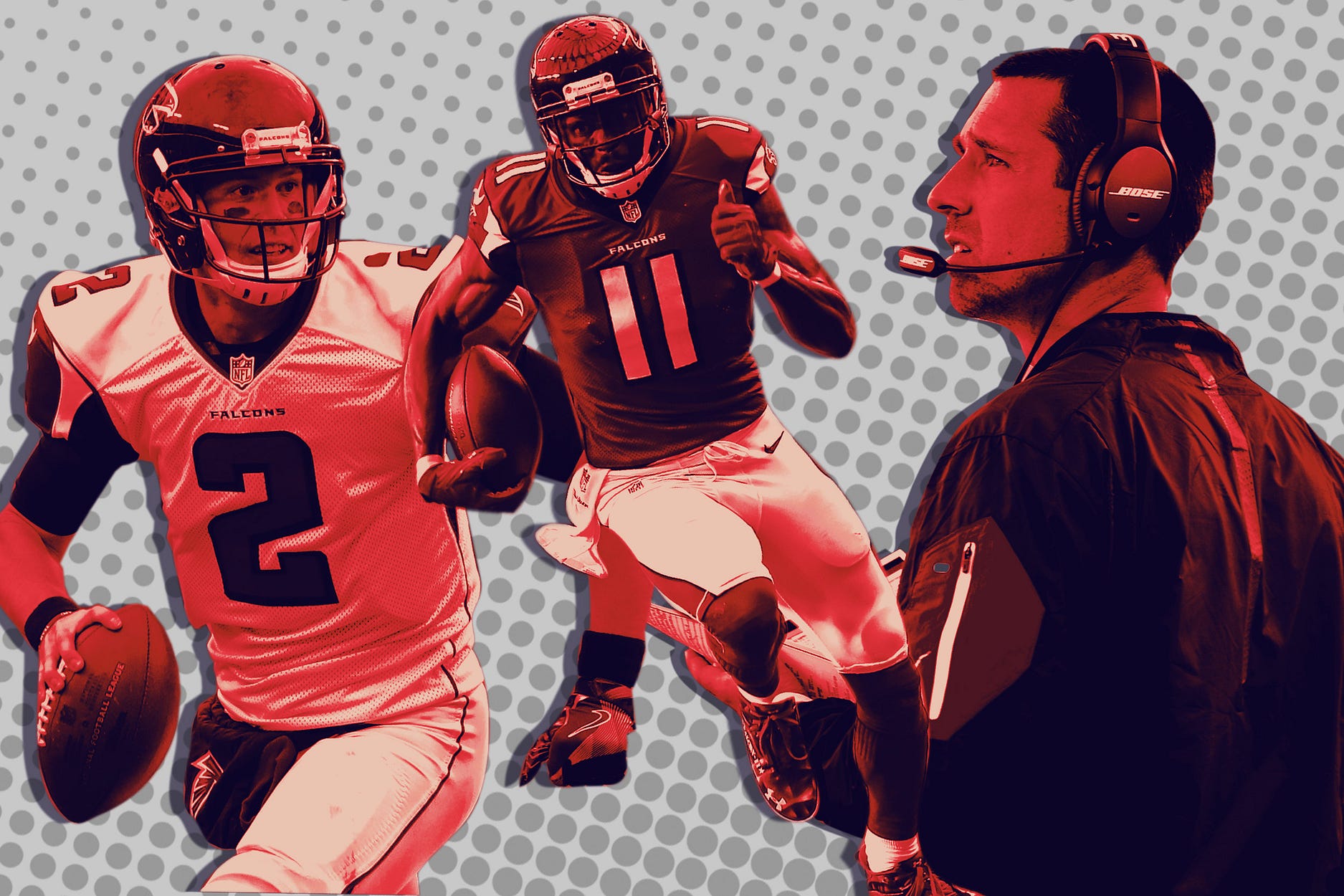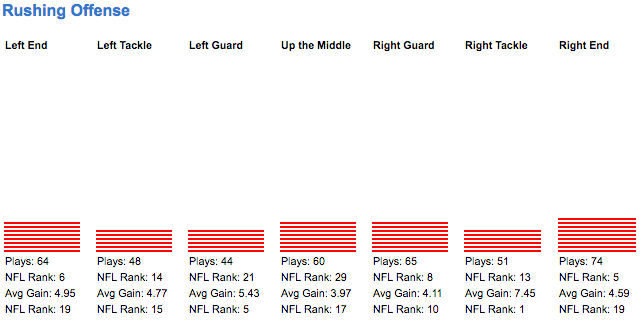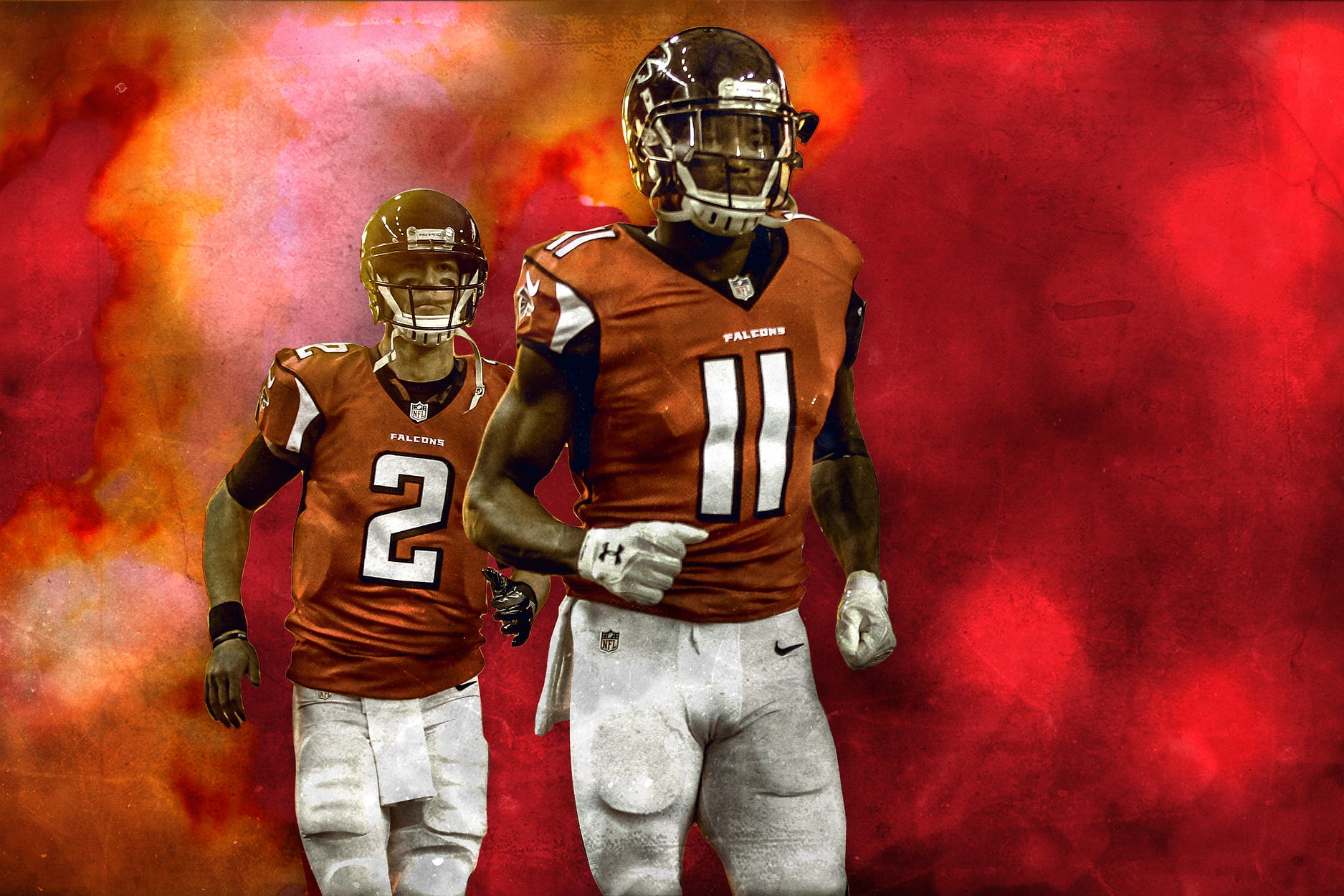- Joined
- Feb 9, 2014
- Messages
- 20,922
- Name
- Peter
https://theringer.com/atlanta-falco...o-jones-kyle-shanahan-557349d74cb6#.g5joz5vuh
The Falcons Offense Needs a Nickname
By balancing things out, Kyle Shanahan, Matt Ryan, Julio Jones, and Co. have created one of the greatest scoring attacks in NFL history
Danny Kelly/Staff Writer, The Ringer

(Getty Images/Ringer illustration)
The Falcons offense hasn’t picked up a catchy nickname that will help it live forever in NFL mythology, but when it posted a league-best 540 points this season, Atlanta matched the scoring output of the legendary Kurt Warner–led “Greatest Show on Turf” Rams from 2000. With deadly efficiency, the Falcons moved into a tie for the eighth-most prolific scoring offense of all time.
Matt Ryan put together an MVP-caliber season. Julio Jones continued to make defensive backs look like JV team backups, and Devonta Freeman and Tevin Coleman combined to provide an explosive run game. But that collection of talent alone wasn’t enough to make the Falcons one of the best offenses in league history.
It took the cunning of an excellent play-caller, Kyle Shanahan, to bring it all together and construct what looks like an unstoppable force as they head into their divisional-round matchup with the Seahawks. Shanahan utilized the full stable of talent at his disposal and deployed it shrewdly in his diverse, versatile scheme. Behind Shanahan’s instinctive play calling, the Falcons were the best offense in the NFL because they were also the most unpredictable.
Atlanta’s offense this year was much more balanced than it was in 2015. Jones was no longer force-fed the football in the passing game. His target share dropped from 33 percent last season to just 24 percent this year, as Mohamed Sanu, Taylor Gabriel, and a combination of tight ends and running backs inherited bigger responsibilities in the passing game.
In the Falcons’ Week 17 win over the Saints, which clinched the 2-seed, Ryan finished 27-of-36 (75 percent) for 331 yards and four touchdowns. Those four scores went to four separate players (Jones, Justin Hardy, Sanu, and Coleman), which highlighted a season-long willingness to spread the love around. Ten Falcons players finished with more than 10 catches and 200 yards receiving, and an NFL record 13 different players caught a touchdown.
Overall, the numbers speak for themselves: The Falcons scored 30-plus points 11 times this season (tied for fifth most in NFL history) and dropped 40 five times (the league record is six). They picked up a league-high 6.7 yards per play and finished second in total yards (6,653), tallying the third-most passing yards (4,725) and fifth-most rushing yards (1,928) in the league. The Falcons were also incredibly efficient — Ryan led the NFL with 9.26 yards per attempt and a league-best 117.1 passer rating — and the offense averaged 3.06 points per drive, which was another “best in the league.”
Shanahan’s offense gave new meaning to the idea of using the whole field. The run game in particular was pretty much devoid of tendency. Look at the play-direction report for their rushing offense, via NFL GSIS stats tracking:

It’s rare to see the plot of run plays spread out so evenly across the offensive line over the course of a season. Most teams’ play-direction reports show huge spikes in one or two areas, whether it’s straight up the gut or off the right tackle. But against the Falcons, opposing defenses couldn’t favor a particular side because scouting wouldn’t show where they might run.
Even though Atlanta wasn’t as efficient in certain directions — off left tackle, up the middle, and off the right end — Shanahan stuck with his balance in order to keep defenses on their toes. The Falcons finished with 4.6 yards per carry (fifth), 20 rushing touchdowns (tied for third behind only the Bills and Cowboys), and 15 run plays of 20-plus yards (fourth).
The passing game utilized the entire field, as well. Shanahan was able to unlock all three levels of opposing defenses this year because Ryan was incredibly accurate in the deep-passing game. He racked up an NFL-best 136.1 passer rating on attempts of 20-plus yards down the field, connecting on 32 of 63 such throws for 1,149 yards and 11 touchdowns with zero picks.
With defenses forced to respect what Atlanta could do on long-ball passes to Jones, Gabriel, and Aldrick Robinson, there was more room to operate underneath. With that cushion, Ryan worked a robust intermediate passing attack out of shotgun looks, on dropbacks from under center, and on bootlegs, effectively mixing in short passes to the wings, quick slants over the middle, and dump-offs to running backs.
With his players executing across all levels, Shanahan’s play calling really shone through. A lot goes into the art of calling plays. An offensive coordinator has to do so many things simultaneously: take advantage of defensive vulnerabilities, mix run and pass plays, avoid patterns and tendencies, and react to adjustments, all while trying to build a rhythm for the quarterback.
The flow of the game becomes a chess match: Run one play to see how the defense reacts to it, then tweak it later to take advantage of any weaknesses the defense presents. Dial up deep shots often enough to keep the safeties and cornerbacks honest, but work the short and intermediate areas as well. Lean on the run — force the defense to make tackles — then run play-action to throw it over their heads when they start cheating toward the line of scrimmage.
Throughout the year, Shanahan, who’s going to be a head coach sooner rather than later, showed that he’s a master of play sequencing. Atlanta’s opening drive in Week 17 was a good example: On the Falcons’ first possession, Shanahan opens with a quick pass to Freeman, who motions out into the right slot, and the running back picks up 13 yards.(Click link above to watch video)
On the next play, Atlanta lines up in the exact same formation, except Ryan looks to his left and hits Justin Hardy on a slant. (Click link above to watch video)
Those two plays set up the third. The first two stressed the Saints defense laterally, and then Shanahan exploited the middle. All four receivers run routes from or toward the sideline, but Freeman leaks into the middle. He finds himself wide open, gaining 35 yards on the dump-off. (Click link above to watch video)
Then, on the next play, the Falcons do the opposite: With three receivers to the left, one route goes deep (a “clear out”), and the other two are in-breaking slants, drawing the Saints defenders into the middle of the field. The running back, Coleman, then releases out of the backfield into the left flat that the New Orleans defenders have just vacated. Coleman catches the ball and, with the help of a little screen by Jones on the linebacker, waltzes into the end zone. (Click link above to watch video)
While this was a scripted drive early in the game, Shanahan does this type of thing all game long, as he accounts for adjustments and defensive tendencies. His offense doesn’t rely on incredibly innovative plays, but the way he strings such varied looks together makes this offense so hard to contain. If this were boxing, Shanahan would be adept at mixing body shots with jabs, working his combinations with an eventual knockout punch in mind.
With Shanahan calling the plays and an unbelievably efficient Ryan executing them, the Falcons can beat you short or long, outside or in traffic, and with a run or a pass. If you have a vulnerability, they’ll look to exploit it, and when you adjust, they have a dozen counter-adjustments to work with.
The Falcons’ 27th-ranked defense by DVOA all too often allows opponents to stay in games, but if anyone’s going to beat Atlanta this postseason, they’re going to have to keep pace with a team whose offensive possessions produced touchdowns (58) almost as often as punts and turnovers combined (59). The Falcons force their opponents to defend the entire field on any given snap, and with Seattle still reeling from the loss of star safety Earl Thomas, the Legion of Boom is about to face its biggest challenge since they got the kind of nickname this Falcons offense deserves.
The Falcons Offense Needs a Nickname
By balancing things out, Kyle Shanahan, Matt Ryan, Julio Jones, and Co. have created one of the greatest scoring attacks in NFL history
Danny Kelly/Staff Writer, The Ringer

(Getty Images/Ringer illustration)
The Falcons offense hasn’t picked up a catchy nickname that will help it live forever in NFL mythology, but when it posted a league-best 540 points this season, Atlanta matched the scoring output of the legendary Kurt Warner–led “Greatest Show on Turf” Rams from 2000. With deadly efficiency, the Falcons moved into a tie for the eighth-most prolific scoring offense of all time.
Matt Ryan put together an MVP-caliber season. Julio Jones continued to make defensive backs look like JV team backups, and Devonta Freeman and Tevin Coleman combined to provide an explosive run game. But that collection of talent alone wasn’t enough to make the Falcons one of the best offenses in league history.
It took the cunning of an excellent play-caller, Kyle Shanahan, to bring it all together and construct what looks like an unstoppable force as they head into their divisional-round matchup with the Seahawks. Shanahan utilized the full stable of talent at his disposal and deployed it shrewdly in his diverse, versatile scheme. Behind Shanahan’s instinctive play calling, the Falcons were the best offense in the NFL because they were also the most unpredictable.
Atlanta’s offense this year was much more balanced than it was in 2015. Jones was no longer force-fed the football in the passing game. His target share dropped from 33 percent last season to just 24 percent this year, as Mohamed Sanu, Taylor Gabriel, and a combination of tight ends and running backs inherited bigger responsibilities in the passing game.
In the Falcons’ Week 17 win over the Saints, which clinched the 2-seed, Ryan finished 27-of-36 (75 percent) for 331 yards and four touchdowns. Those four scores went to four separate players (Jones, Justin Hardy, Sanu, and Coleman), which highlighted a season-long willingness to spread the love around. Ten Falcons players finished with more than 10 catches and 200 yards receiving, and an NFL record 13 different players caught a touchdown.
Overall, the numbers speak for themselves: The Falcons scored 30-plus points 11 times this season (tied for fifth most in NFL history) and dropped 40 five times (the league record is six). They picked up a league-high 6.7 yards per play and finished second in total yards (6,653), tallying the third-most passing yards (4,725) and fifth-most rushing yards (1,928) in the league. The Falcons were also incredibly efficient — Ryan led the NFL with 9.26 yards per attempt and a league-best 117.1 passer rating — and the offense averaged 3.06 points per drive, which was another “best in the league.”
Shanahan’s offense gave new meaning to the idea of using the whole field. The run game in particular was pretty much devoid of tendency. Look at the play-direction report for their rushing offense, via NFL GSIS stats tracking:

It’s rare to see the plot of run plays spread out so evenly across the offensive line over the course of a season. Most teams’ play-direction reports show huge spikes in one or two areas, whether it’s straight up the gut or off the right tackle. But against the Falcons, opposing defenses couldn’t favor a particular side because scouting wouldn’t show where they might run.
Even though Atlanta wasn’t as efficient in certain directions — off left tackle, up the middle, and off the right end — Shanahan stuck with his balance in order to keep defenses on their toes. The Falcons finished with 4.6 yards per carry (fifth), 20 rushing touchdowns (tied for third behind only the Bills and Cowboys), and 15 run plays of 20-plus yards (fourth).
The passing game utilized the entire field, as well. Shanahan was able to unlock all three levels of opposing defenses this year because Ryan was incredibly accurate in the deep-passing game. He racked up an NFL-best 136.1 passer rating on attempts of 20-plus yards down the field, connecting on 32 of 63 such throws for 1,149 yards and 11 touchdowns with zero picks.
With defenses forced to respect what Atlanta could do on long-ball passes to Jones, Gabriel, and Aldrick Robinson, there was more room to operate underneath. With that cushion, Ryan worked a robust intermediate passing attack out of shotgun looks, on dropbacks from under center, and on bootlegs, effectively mixing in short passes to the wings, quick slants over the middle, and dump-offs to running backs.
With his players executing across all levels, Shanahan’s play calling really shone through. A lot goes into the art of calling plays. An offensive coordinator has to do so many things simultaneously: take advantage of defensive vulnerabilities, mix run and pass plays, avoid patterns and tendencies, and react to adjustments, all while trying to build a rhythm for the quarterback.
The flow of the game becomes a chess match: Run one play to see how the defense reacts to it, then tweak it later to take advantage of any weaknesses the defense presents. Dial up deep shots often enough to keep the safeties and cornerbacks honest, but work the short and intermediate areas as well. Lean on the run — force the defense to make tackles — then run play-action to throw it over their heads when they start cheating toward the line of scrimmage.
Throughout the year, Shanahan, who’s going to be a head coach sooner rather than later, showed that he’s a master of play sequencing. Atlanta’s opening drive in Week 17 was a good example: On the Falcons’ first possession, Shanahan opens with a quick pass to Freeman, who motions out into the right slot, and the running back picks up 13 yards.(Click link above to watch video)
On the next play, Atlanta lines up in the exact same formation, except Ryan looks to his left and hits Justin Hardy on a slant. (Click link above to watch video)
Those two plays set up the third. The first two stressed the Saints defense laterally, and then Shanahan exploited the middle. All four receivers run routes from or toward the sideline, but Freeman leaks into the middle. He finds himself wide open, gaining 35 yards on the dump-off. (Click link above to watch video)
Then, on the next play, the Falcons do the opposite: With three receivers to the left, one route goes deep (a “clear out”), and the other two are in-breaking slants, drawing the Saints defenders into the middle of the field. The running back, Coleman, then releases out of the backfield into the left flat that the New Orleans defenders have just vacated. Coleman catches the ball and, with the help of a little screen by Jones on the linebacker, waltzes into the end zone. (Click link above to watch video)
While this was a scripted drive early in the game, Shanahan does this type of thing all game long, as he accounts for adjustments and defensive tendencies. His offense doesn’t rely on incredibly innovative plays, but the way he strings such varied looks together makes this offense so hard to contain. If this were boxing, Shanahan would be adept at mixing body shots with jabs, working his combinations with an eventual knockout punch in mind.
With Shanahan calling the plays and an unbelievably efficient Ryan executing them, the Falcons can beat you short or long, outside or in traffic, and with a run or a pass. If you have a vulnerability, they’ll look to exploit it, and when you adjust, they have a dozen counter-adjustments to work with.
The Falcons’ 27th-ranked defense by DVOA all too often allows opponents to stay in games, but if anyone’s going to beat Atlanta this postseason, they’re going to have to keep pace with a team whose offensive possessions produced touchdowns (58) almost as often as punts and turnovers combined (59). The Falcons force their opponents to defend the entire field on any given snap, and with Seattle still reeling from the loss of star safety Earl Thomas, the Legion of Boom is about to face its biggest challenge since they got the kind of nickname this Falcons offense deserves.







